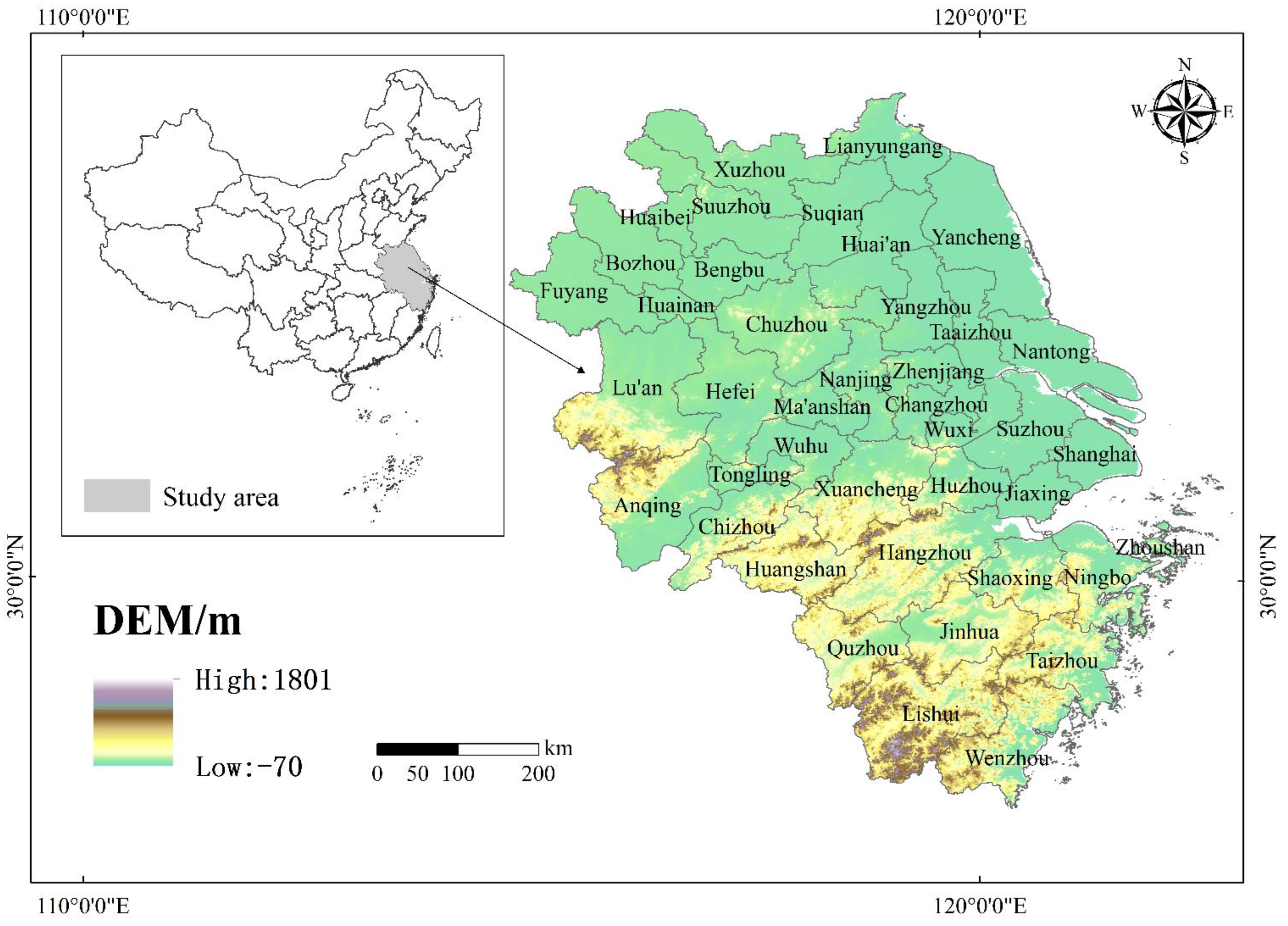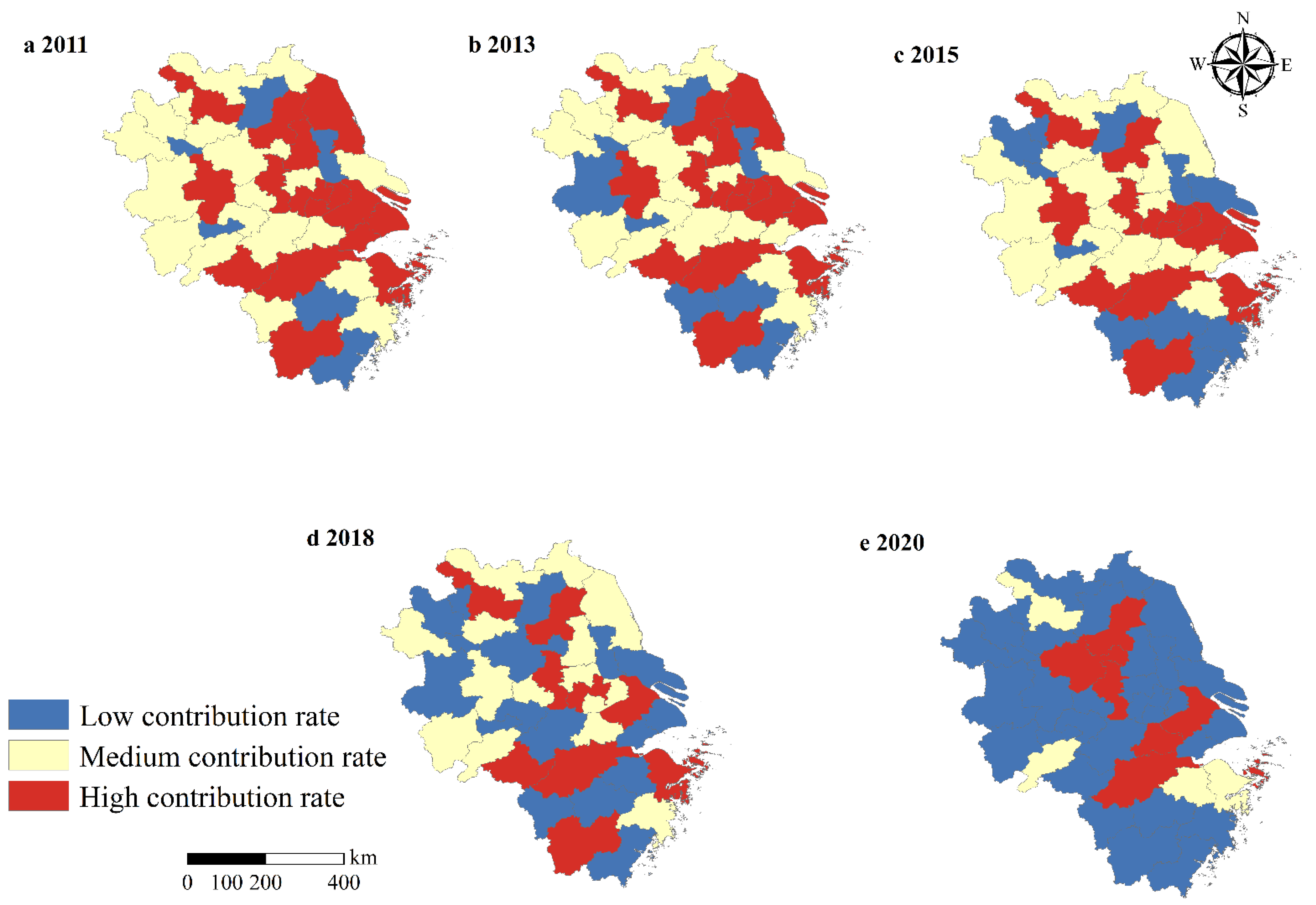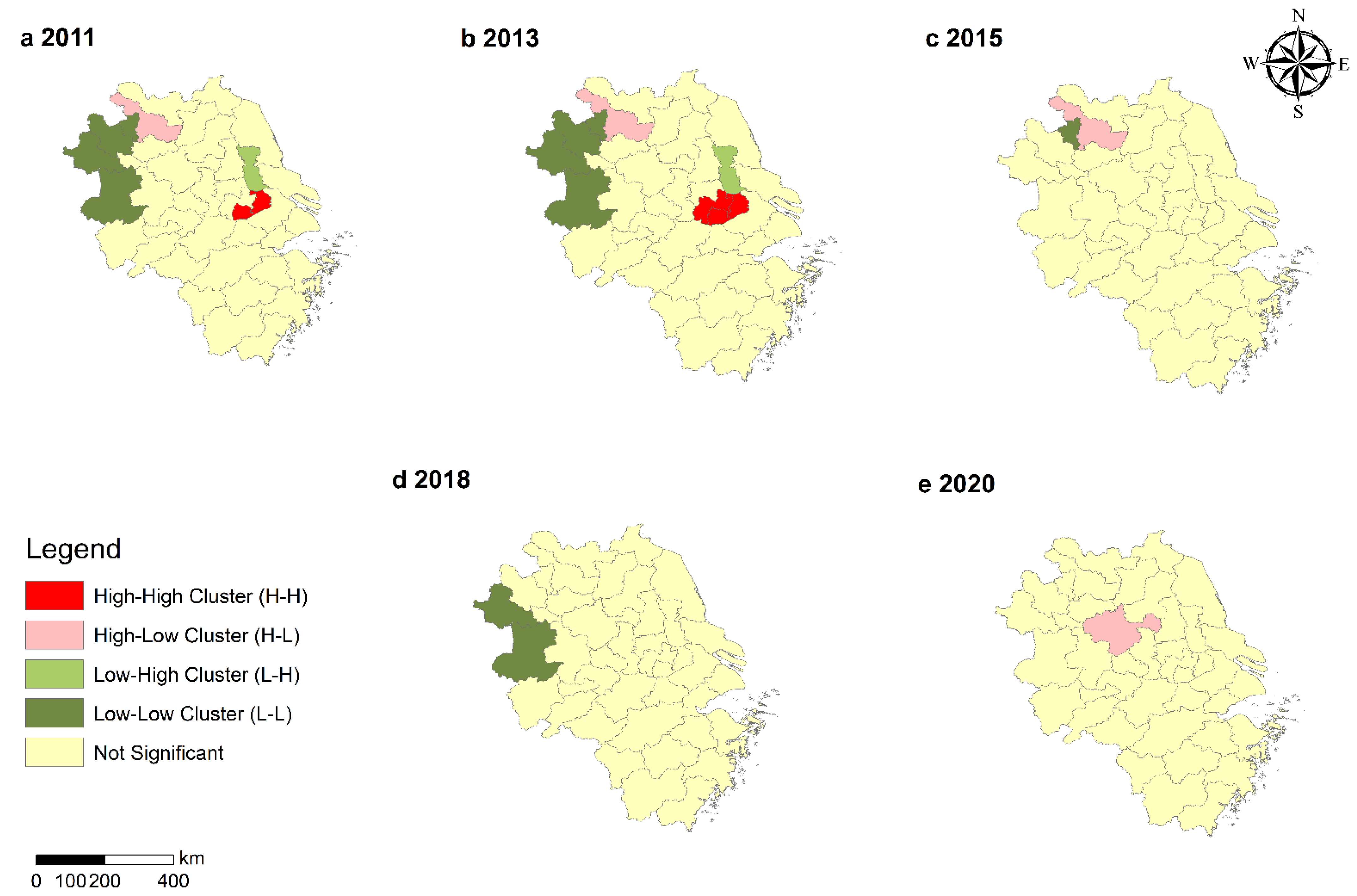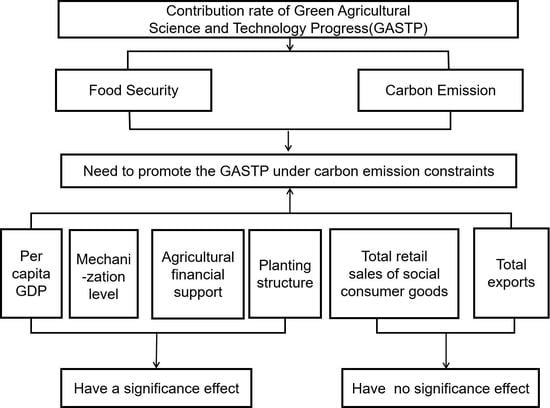Spatio-Temporal Pattern of Green Agricultural Science and Technology Progress: A Case Study in Yangtze River Delta of China
Abstract
:1. Introduction
2. Materials and Methods
2.1. Study Area
2.2. Methodology
2.2.1. Measurement of the Contribution Rate of GASTP
- Index Selection
- 2.
- The Super-SBM Model Using Undesirable Output
2.2.2. Spatio-Temporal Pattern of Contribution Rate of GASTP
2.2.3. Panel Data Model
2.3. Data
3. Results
3.1. Analysis of Spatio-Temporal Pattern
3.2. Analysis of Spatial Correlation Characteristics
3.3. Driving Mechanism Analysis
4. Discussion
4.1. Spatio-Temporal Pattern under Carbon Emission Constraints
4.2. Spatial Correlation Characteristics
4.3. Driving Mechanism Analysis
4.4. Implication and Limitation
5. Conclusions
Author Contributions
Funding
Institutional Review Board Statement
Informed Consent Statement
Data Availability Statement
Conflicts of Interest
References
- Saul, N. Empirical analysis on the impact of the COVID-19 pandemic on food insecurity in South Africa. Phys. Chem. Earth Parts A/B/C 2022, 103180. [Google Scholar] [CrossRef]
- Xu, B.; Lin, B. Factors affecting CO2 emissions in China’s agriculture sector: Evidence from geographically weighted regression model. Energy Policy 2017, 104, 404–414. [Google Scholar] [CrossRef]
- FAO. The State of Food Security and Nutrition in the World 2021; FAO: Rome, Italy, 2021. [Google Scholar]
- IPCC. Climate Change 2022: Mitigation of Climate Change—Summary for Policymakers; IPCC: New York, NY, USA, 2022. [Google Scholar]
- Liu, D.; Zhu, X.; Wang, Y. China’s agricultural green total factor productivity based on carbon emission: An analysis of evolution trend and influencing factors. J. Clean. Prod. 2021, 278, 123692. [Google Scholar] [CrossRef]
- Wang, J.; Song, H.; Tian, Z.; Bei, J.; Zhang, H.; Ye, B.; Ni, J. A Method for Estimating Output Elasticity of Input Factors in Cobb-Douglas Production Function and Measuring Agricultural Technological Progress. IEEE Access 2021, 9, 26234–26250. [Google Scholar] [CrossRef]
- Deng, Y.; Cui, Y.; Khan, S.U.; Zhao, M.; Lu, Q. The spatiotemporal dynamic and spatial spillover effect of agricultural green technological progress in China. Env. Sci. Pollut. Res. Int. 2022, 29, 27909–27923. [Google Scholar] [CrossRef]
- Guo, H.; Hu, J.; Yu, S.; Sun, H.; Chen, Y. Computing of the contribution rate of scientific and technological progress to economic growth in Chinese regions. Expert Syst. Appl. 2012, 39, 8514–8521. [Google Scholar] [CrossRef]
- Solow, R.M. Technical Change and the Aggregate Production Function. Rev. Econ. Stat. 1957, 39, 312–320. [Google Scholar] [CrossRef] [Green Version]
- Mao, W.; Koo, W.W. Productivity Growth, Technology Progress, and Efficiency Change in Chinese Agricultural Production From 1984 to 1993. Agricultural Economics Report No. 362. Available online: https://ssrn.com/abstract=15076 (accessed on 11 July 2022).
- Wang, L.; Wang, H.; Dong, Z. Policy Conditions for Compatibility between Economic Growth and Environmental Quality: A Test of Policy Bias Effects from the Perspective of the Direction of Environmental Technological Progress. Manag. World 2020, 36, 39–60. [Google Scholar]
- Zhong, R.; He, Q.; Qi, Y. Digital Economy, Agricultural Technological Progress, and Agricultural Carbon Intensity: Evidence from China. Int. J. Environ. Res. Public Health 2022, 19, 6488. [Google Scholar] [CrossRef]
- Ge, X. Study on the Effect of Agricultural Technological Progress on Agricultural Carbon emission effectualness. For. Chem. Rev. 2022, 78–97. Available online: http://www.forestchemicalsreview.com/index.php/JFCR/article/view/697 (accessed on 11 July 2022).
- Laura, M.; Stanislava, M.; Zita, K.; Danute, J.; Ling, Z.; Egidijus, S. Effect of cover crops in smothering weeds and volunteer plants in alternative farming systems. Crop. Prot. 2017, 91, 74–81. [Google Scholar]
- Tian, Y.; Yin, M. Have technological advances contributed to carbon reductions in agro-energy? — Based on the test of rebound effect and spatial spillover effect. J. Reform. 2021, 12, 45–58. [Google Scholar]
- Wei, W.; Yang, F. Impact of Technology Advance on Carbon Dioxide Emission in China. Stat. Res. 2010, 27, 36–44. [Google Scholar]
- Lu, Z. Study on the impact of agricultural scientific and technological progress on agricultural carbon emissions from a provincial perspective. Sci. Res. 2013, 31, 674–683. [Google Scholar]
- Zhang, S.; Wang, H.; Xu, R. Analysis of the relationship between scientific and technological progress, green total factor productivity and agricultural carbon emissions: Based on panel data of 26 cities in the Pan-Yangtze River Delta. Sci. Technol. Manag. Res. 2021, 41, 211–218. [Google Scholar]
- Ji, H.; Arber, H. Green economy based perspective of low-carbon agriculture growth for total factor energy efficiency improvement. Int. J. Syst. Assur. Eng. Manag. 2021, 13, 353–363. [Google Scholar] [CrossRef]
- Han, H.; Zhong, Z.; Wen, C.; Sun, H. Agricultural environmental total factor productivity in China under technological heterogeneity: Characteristics and determinants. Environ. Sci. Pollut. Res. Int. 2018, 25, 32096–32111. [Google Scholar] [CrossRef]
- Yang, X.; Chen, Y.; Gao, R. A Study on Total Factor Productivity of Agriculture in Gansu Province under Environmental Efficiency and Carbon Emission Constraints. Agric. Resour. Zoning China 2021, 42, 13–20. [Google Scholar]
- Liu, Y.; Yang, Y.; Zheng, S.; Xiao, L.; Gao, H.; Lu, H. Dynamic Impact of Technology and Finance on Green Technology Innovation Efficiency: Empirical Evidence from China’s Provinces. Int. J. Environ. Res. Public Health 2022, 19, 4764. [Google Scholar] [CrossRef]
- Li, F.; Zhou, X.; Zhou, Y. Evaluation of the level of green development of agriculture in the Bohai Rim and analysis of regional differences. Agric. Resour. Zoning China 2022, 1–13. Available online: http://kns.cnki.net/kcms/detail/11.3513.S.20220318.1604.028.html (accessed on 11 July 2022).
- Zhang, F.; Wang, F.; Hao, R.; Wu, L. Agricultural Science and Technology Innovation, Spatial Spillover and Agricultural Green Development—Taking 30 Provinces in China as the Research Object. Appl. Sci. 2022, 12, 845. [Google Scholar] [CrossRef]
- Zhang, Y.; Tian, Y.; Wang, Y.; Wang, R.; Peng, Y. Rural Human Capital, Agricultural Technology Progress and Agricultural Carbon Emissions. Sci. Technol. Manag. Res. 2019, 39, 266–274. [Google Scholar]
- Shanghai Academy of Social Sciences: Overview of Agricultural Development in the Yangtze River Delta and Regional Comparison [M/CD]. Available online: https://cyrdebr.sass.org.cn/2020/1120/c5524a99196/page.htm (accessed on 11 July 2022).
- Yang, Q.; Wang, J.; Li, C.; Liu, X. Spatial differentiation and drivers of green total factor productivity in agriculture in China. Quant. Tech. Econ. Res. 2019, 36, 21–37. [Google Scholar]
- Wu, X.; Zhang, J.; Tian, Y.; Li, P. Agricultural carbon emissions in China’s provinces: A study of measurement, efficiency changes and influencing factors based on DEA-Malmquist index decomposition method and Tobit model application. Resour. Sci. 2014, 36, 129–138. [Google Scholar]
- Tone, K. A slacks-based measure of super-efficiency in data envelopment analysis. Eur. J. Oper. Res. 2002, 143, 32–41. [Google Scholar] [CrossRef] [Green Version]
- Zhao, P.; Zeng, L.; Lu, H.; Zhou, Y.; Hu, H.; Wei, X. Green economic efficiency and its influencing factors in China from 2008 to 2017: Based on the super-SBM model with undesirable outputs and spatial Dubin model. Sci. Total Environ. 2020, 741, 140026. [Google Scholar] [CrossRef]
- Zhou, C.; Shi, C.; Wang, S.; Zhang, G. Estimation of eco-efficiency and its influencing factors in Guangdong province based on Super-SBM and panel regression models. Ecol. Indic. 2018, 86, 67–80. [Google Scholar] [CrossRef]
- Liang, L.; Qu, F.; Feng, S. Measurement of agricultural technical efficiency based on the perspective of environmental pollution constraints. J. Nat. Resour. 2012, 27, 1580–1589. [Google Scholar]
- Xie, C.; Huang, C.; Xu, H. Regional differences and factors influencing the technical efficiency of Chinese agriculture under environmental regulations: A perspective based on the dual constraints of agricultural carbon emissions and agricultural surface pollution. Sci. Technol. Manag. Res. 2021, 41, 184–190. [Google Scholar]
- Qian, L.; Xiao, R.; Chen, Z. A study of inter-provincial agricultural production efficiency and its influencing factors in China under the carbon emission constraint. Econ. Theory Econ. Manag. 2013, 9, 100–112. [Google Scholar]
- Chen, Y.; Miao, J.; Zhu, Z. Measuring green total factor productivity of China’s agricultural sector: A three-stage SBM-DEA model with non-point source pollution and CO2 emissions. J. Clean. Prod. 2021, 318, 128543. [Google Scholar] [CrossRef]




| Index Types | First Level Index | Variable Declaration |
|---|---|---|
| Inputs | Labor | Number of employees in the first industry (million people) |
| Capital | Total power of agricultural machinery (millions of kw) | |
| Land | Total sown area of crops (hectare) | |
| Energy | Rural electricity consumption (millions of kw/h) | |
| Water | Effective irrigation area (hectare) | |
| Desirable output | Economic | Total output value of agriculture, forestry, animal husbandry, and fishery (billion yuan) |
| Undesirable outputs | Exhaust | Sum of carbon emissions from agricultural plastic film use, diesel use, pesticide use, year-end cattle stock, year-end pig stock, and year-end sheep stock. The calculation method is calculated by drawing on the practices of Tian Yun [28] and others (t) |
| Variables | Mean | Std. Dev | Minimum | Maximum |
|---|---|---|---|---|
| Per capita GDP | 15.90 | 0.86 | 13.45 | 17.46 |
| Agricultural financial support | 0.11 | 0.05 | 0.03 | 0.86 |
| Total retail sales of social consumer goods | 10.01 | 1.41 | 6.74 | 13.96 |
| Total exports | 211.22 | 421.83 | 0.91 | 2102.77 |
| Planting structure | 5.54 | 3.04 | 1.35 | 25.87 |
| Agricultural mechanization level | 0.67 | 0.45 | 0.1 | 9.13 |
| Year | I | p-Value | Z-Value | E [I] | Mean | Sd |
|---|---|---|---|---|---|---|
| 2011 | 0.136 | 0.008 | 2.785 *** | −0.025 | −0.023 | 0.057 |
| 2012 | 0.155 | 0.004 | 3.143 *** | −0.025 | −0.024 | 0.057 |
| 2013 | 0.141 | 0.007 | 2.892 *** | −0.025 | −0.024 | 0.057 |
| 2014 | 0.134 | 0.012 | 2.812 *** | −0.025 | −0.025 | 0.056 |
| 2015 | 0.135 | 0.006 | 2.738 *** | −0.025 | −0.022 | 0.058 |
| 2016 | 0.110 | 0.019 | 2.350 ** | −0.025 | −0.023 | 0.057 |
| 2017 | −0.076 | 0.181 | −0.910 | −0.025 | −0.025 | 0.056 |
| 2018 | 0.141 | 0.007 | 3.011 *** | −0.025 | −0.025 | 0.055 |
| 2019 | 0.137 | 0.006 | 2.883 *** | −0.025 | −0.024 | 0.056 |
| 2020 | 0.041 | 0.129 | 1.160 | −0.025 | −0.023 | 0.056 |
| Variables | Contribution Rate of GASTP | ||
|---|---|---|---|
| FE | RE | OLS | |
| Per capita GDP | −0.20 ** | −0.08 | 0.11 ** |
| (−0.09) | (−0.93) | (−0.04) | |
| Agricultural financial support | −0.19 * | −0.06 | 0.77 * |
| (−0.10) | (−0.49) | (−0.42) | |
| Total retail sales of social consumer goods | −0.05 | −0.1 | 0.08 *** |
| (−0.05) | (−1.52) | (−0.03) | |
| Total exports | 0.00 | 0.00 *** | 0.00 *** |
| 0.00 | (−4.18) | 0.00 | |
| Planting structure | 0.09 *** | 0.08 *** | −0.03 |
| (−0.01) | (−7.19) | (−0.05) | |
| Agricultural mechanization level | −0.02 * | −0.02 | 0.02 *** |
| (−0.01) | (−1.48) | (−0.01) | |
| Constant | 3.22 *** | 2.23 *** | −0.17 |
| (−0.71) | (−3.45) | (−0.41) | |
Publisher’s Note: MDPI stays neutral with regard to jurisdictional claims in published maps and institutional affiliations. |
© 2022 by the authors. Licensee MDPI, Basel, Switzerland. This article is an open access article distributed under the terms and conditions of the Creative Commons Attribution (CC BY) license (https://creativecommons.org/licenses/by/4.0/).
Share and Cite
Qian, C.; Xu, C.; Kong, F. Spatio-Temporal Pattern of Green Agricultural Science and Technology Progress: A Case Study in Yangtze River Delta of China. Int. J. Environ. Res. Public Health 2022, 19, 8702. https://doi.org/10.3390/ijerph19148702
Qian C, Xu C, Kong F. Spatio-Temporal Pattern of Green Agricultural Science and Technology Progress: A Case Study in Yangtze River Delta of China. International Journal of Environmental Research and Public Health. 2022; 19(14):8702. https://doi.org/10.3390/ijerph19148702
Chicago/Turabian StyleQian, Chen, Caiyao Xu, and Fanbin Kong. 2022. "Spatio-Temporal Pattern of Green Agricultural Science and Technology Progress: A Case Study in Yangtze River Delta of China" International Journal of Environmental Research and Public Health 19, no. 14: 8702. https://doi.org/10.3390/ijerph19148702
APA StyleQian, C., Xu, C., & Kong, F. (2022). Spatio-Temporal Pattern of Green Agricultural Science and Technology Progress: A Case Study in Yangtze River Delta of China. International Journal of Environmental Research and Public Health, 19(14), 8702. https://doi.org/10.3390/ijerph19148702








